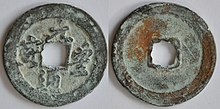
Cash coins with flower (rosette) holes (traditional Chinese: 花穿錢; simplified Chinese: 花穿钱; pinyin: huā chuān qián) are a type of cash coin with an octagonal hole as opposed to a square one, they have a very long history possibly dating back to the first Ban Liang (半兩) cash coins cast under the State of Qin or the Han dynasty.[1] Cash coins are characterised by their round shape and square hole, but Huachuanqian are cash coins with an octagonal hole.[2] These octagonal holes are mostly found in Chinese cash coins, but are in some rare instances also found in Japanese, Korean, and Vietnamese cash coins.
During the imperial period in Chinese history a relatively small number of Chinese cash coins were minted with what are termed "flower holes", "chestnut holes" or "rosette holes", these holes were octagonal but resembled the shape of flowers.[3] The exact origin and purpose of these variant holes is currently unknown but several hypotheses have been proposed by Chinese scholars.[4] While Huachuanqian are believed to have disappeared in China following the transition from Ming to Qing, they continued to appear among Korean cash coins until the Koreans abolished their cash coins.
Western numismatic sources often refer to these cash coins as having "star" holes.[5] Among coin collectors Huachuanqian sell for a premium compared to their square holed counterparts with the same inscription.[5] If the shape of these holes were only hexagonal then they were referred to as "turtle shell hole coins" (龜甲穿錢).[6]
While initially the field of Chinese numismatics neglected the study of Huachuanqian, after an article published in the journal Chinese Numismatics in 1994 brought this phenomenon to mainstream attention, wider interest in these cash coins was generated and they have since been seen as their own separate category of cash coins.
- ^ 《简明古钱辞典》又曰:"花穿为古钱浇铸,穿孔错位不成方形,谓之'菱花穿'。"见诸报道的花穿钱,最早出现在秦半两钱上。
- ^ Zhang Hongming (张宏明) - The timespan and origins of Flower Hole Money (花穿钱的时代与成因问题) - "Chinese Numismatics", Issue 3, 1994 (《中国钱币》1994年 第3期). - Quote: "方孔钱的外形始终保持着圆形的定式,穿孔部分则有一些小的变化。有一种被人们称之为"花穿"或"龟甲穿"的穿孔,其钱穿形状六角或八角,极其新颖别致...".
- ^ Chen Lianting (陈联廷) - 怎样寻觅花穿钱 - Shouchang Jie, issue 88, 2008 (收藏界, 88, 2008). Quote: "在方孔钱上,盛开着一朵奇异的小花,这就是独树一帜的花穿钱.所谓花穿钱,是指方孔钱的穿廓部位在外形上有些微妙变化.其钱的穿孔呈八角形态,穿似花朵,新颖别致.它改变了方孔钱的单调形式,在表现形式上更具有独特的艺术魅力.这种异形穿孔钱,称之为花穿钱(如图1).".
- ^ Yu Fang (于放) - A Group of Letters Concerning the Article "The timespan and origins of Flower Hole Money" (关于《花穿钱的时代与成因问题》一文的来信一组) - "Chinese Numismatics", Issue 4, 1994 (《中国钱币》1994年 第4期).
- ^ a b Robert Kokotailo (2002). "Medieval Chinese Coins - The Northern Sung Dynasty". Calgary Coin Gallery. Retrieved 16 August 2023.
- ^ Zhang Xianzhong (张先忠) - Analysis of flower hole money (花穿钱浅析) - "Anhui Numismatics" 2009 No. 2 (《安徽钱币》2009年 第2期).